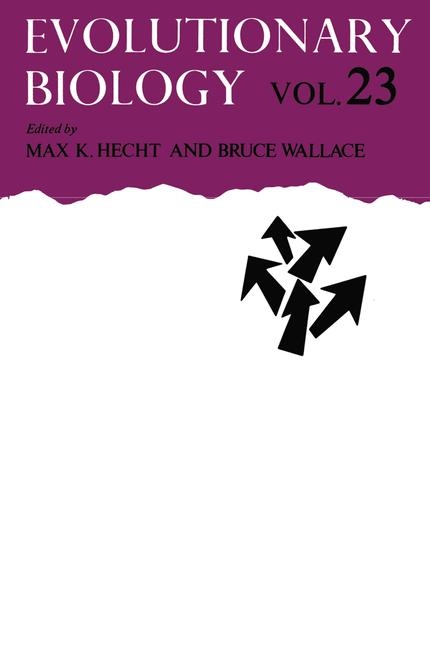
Evolutionary Biology
Kluwer Academic/Plenum Publishers (Verlag)
978-0-306-42977-4 (ISBN)
- Titel ist leider vergriffen;
keine Neuauflage - Artikel merken
MaintenanceofaHereditaryVirus:TheSigmaVirusin PopulationsofItsHost, Drosophila melanogaster 1 Annie Fleuriet Introduction 1 FrenchPopulationsof Drosophila melanogaster...2 PolymorphismofPopulations 2 CharacteristicsofWildStrainsoftheSigmaVirus 3 EffectsoftheInfectionuponCarriers...7 ExperimentalPopulations...9 MaintenanceoftheVirusinFrenchNaturalPopulations...12 GeographicalVariationofthe Drosophila-SigmaSystem 14 PolymorphismofPopulations 14 ViralCharacteristics...17 TentativeInterpretationoftheGeographicalPatternObserved 18 OtherSystemsofVerticallyTransmittedViruses 22 ExistenceofDifferentSensitivitiestotheVirus 22 CharacteristicsoftheViruses...23 MaintenanceintheVectorPopulation 24 Appendix:TransmissionofStabilizedandNonstabilized Conditions...26 Self-MaintenanceofStabilizedConditionthroughMaternal Lineage...26 NonstabilizedCondition ...27 References 28 2. Domestication:EvolutionaryChangeunderStress 31 M. J. Kohane and P. A. Parsons Introduction 31 EnvironmentalChangeandDomestication 33 Ix x Contents EcologicalPhenotypes 33 BehavioralPhenotypes...36 AdaptationtoLaboratoryConditions...37 ACaseStudy:DomesticationinFoxes 41 Discussion...43 Summary...45 References 46 3.
RangeExpansionandItsGeneticConsequencesinPopulationsof theGiantToad, Bufo marinus...49 Simon Easteal Introduction 49 TheSpreadof Bufo marinus 50 TheIntroductions...50 TheAustralianRangeExpansion 52 GeneticVariationintheIntroducedPopulations...58 TheData...58 GeneticVariability...58 EffectivePopulationSize 62 Dispersal,GeneFlow,andNeighborhoodSize 63 TheGeneticEffectsofRangeExpansion 64 GeographicalPatternsofVariation 74 Conclusion 81 References 82 4. EvolutionbySocialSelection...85 Shozo Yokoyama Introduction 85 ConceptofSocialSelection...86 EvidenceforSocialSelection;...88 MultipleNeurofibromatosis 88 HuntingtonDisease 89 MentalRetardation...90 Schizophrenia 91 SocialSelectionModels...91 AutosomalGenes...92 Contents xl X-LinkedGenes...103 RandomGeneticDriftandVariableSelectionIntensity...112 MaternalEffects 115 DNAPolymorphismandSocialSelection...117 Discussion...118 Summary...121 References 122 5. TheInfluenceofTaxonomicMethodonthePerceptionofPatterns ofEvolution...-...127 Andrew B. Smith and Colin Patterson Introduction 127 TheNatureofTaxa...129 WhyNonmonophyleticGroupsAreNotRealTaxa 131 ParaphyleticTaxaasNaturalAdaptivelyUnifiedGroups.
, 131 NonmonophyleticGroupsasValidSamplesof Species-LevelProcesses...132 TheRedQueenHypothesis 134 TaxonDurationIsProportionaltotheNumberofSpecies IncludedintheTaxon 135 TaxonomicExtinctionsunderConsiderationAreLargely Artefactual 139 TheRedQueenasSystematist:TheProbabilityThata TaxonomistWillSplitaGroupIsInverselyProportional totheNumberofSpeciesinThatGroup 142 DecreaseinExtinctionRatethroughTime 142 PeriodicityofExtinction 143 GenericDataandLagerstatten 147 SpeciesDiversity 148 WhatDoFossilSpeciesSample? 152 AnalysisofGaps 153 Summary...
1. Maintenance of a Hereditary Virus: The Sigma Virus in Populations of Its Host, Drosophila melanogaster.- French Populations of Drosophila melanogaster.- Polymorphism of Populations.- Characteristics of Wild Strains of the Sigma Virus.- Effects of the Infection upon Carriers.- Experimental Populations.- Maintenance of the Virus in French Natural Populations.- Geographical Variation of the Drosophila—Sigma System.- Polymorphism of Populations.- Viral Characteristics.- Tentative Interpretation of the Geographical Pattern Observed.- Other Systems of Vertically Transmitted Viruses.- Existence of Different Sensitivities to the Virus.- Characteristics of the Viruses.- Maintenance in the Vector Population.- Appendix: Transmission of Stabilized and Nonstabilized Conditions.- Self-Maintenance of Stabilized Condition through Maternal Lineage.- Nonstabilized Condition.- References.- 2. Domestication: Evolutionary Change under Stress.- Environmental Change and Domestication.- Ecological Phenotypes.- Behavioral Phenotypes.- Adaptation to Laboratory Conditions.- A Case Study: Domestication in Foxes.- Discussion.- Summary.- References.- 3. Range Expansion and Its Genetic Consequences in Populations of the Giant Toad, Bufo marinus.- The Spread of Bufo marinus.- The Introductions.- The Australian Range Expansion.- Genetic Variation in the Introduced Populations.- The Data.- Genetic Variability.- Effective Population Size.- Dispersal, Gene Flow, and Neighborhood Size.- The Genetic Effects of Range Expansion.- Geographical Patterns of Variation.- Conclusion.- References.- 4. Evolution by Social Selection.- Concept of Social Selection.- Evidence for Social Selection.- Multiple Neurofibromatosis.- Huntington Disease.- Mental Retardation.- Schizophrenia.- Social Selection Models.- Autosomal Genes.- X-Linked Genes.- Random Genetic Drift and Variable Selection Intensity.- Maternal Effects.- DNA Polymorphism and Social Selection.- Discussion.- Summary.- References.- 5. The Influence of Taxonomic Method on the Perception of Patterns of Evolution.- The Nature of Taxa.- Why Nonmonophyletic Groups Are Not Real Taxa.- Paraphyletic Taxa as Natural Adaptively Unified Groups.- Nonmonophyletic Groups as Valid Samples of Species-Level Processes.- The Red Queen Hypothesis.- Taxon Duration Is Proportional to the Number of Species Included in the Taxon.- Taxonomic Extinctions under Consideration Are Largely Artefactual.- The Red Queen as Systematist: The Probability That a Taxonomist Will Split a Group Is Inversely Proportional to the Number of Species in That Group.- Decrease in Extinction Rate through Time.- Periodicity of Extinction.- Generic Data and Lagerstätten.- Species Diversity.- What Do Fossil Species Sample?.- Analysis of Gaps.- Summary.- Appendix 1: Families, Genera, and Species of Echinoderm Listed as Extinct in Sepkoski’s Compendia That Have Been Checked.- Families.- Genera and Species.- Appendix 2: Families, Genera, and Species of Fishes That Have Been Checked.- Families.- Genera and Species.- References.- References for Appendix 1.- References for Appendix 2.- 6. Genetic Diversity in Nature: Patterns and Theory.- The Problem.- A Promising Solution.- The Evidence.- Microgeographic Stress Studies in the Field and Laboratory.- Macrogeographic Regional Studies across Israel.- Macrogeographic Global Studies of Protein Diversity Worldwide.- The Theory.- How Much of the Genetic Diversity in Nature Is Adaptive?.- The Genetic-Environmental Methodology: Weaknesses and Strengths.- Does the Evidence of Molecular Polymorphism in Nature Support the Neutral Theory of Molecular Evolution?.- Patterns of Genetic Diversity and Their Presumed Physiological Function.- Maintenance of Polymorphisms.- The Matching of Evidence and Selective Theoretical Models.- Conclusions and Prospects.- Summary.- References.- 7. Challenges to the Evolutionary Synthesis.- How Should We Interpret the Synthesis.- Biased Variation, Internal Dynamics, and Evolutionary Conservatism Hierarchy.- Hierarchy.- Unifying Theories.- An Optimistic Conclusion.- References.- 8. Evolution and Genetics of Epigean and Cave Astyanax fasciatus (Characidae, Pisces): Support for the Neutral Mutation Theory.- Taxonomy and Distribution of Epi- and Hypogean Astyanax fasciatus.- The Epigean Fish.- The Hypogean Fish.- Preadaptive Traits.- Lateral Line System.- Auditory Capacity.- Olfactory Organ.- Sexual Behavior.- Regressive Traits.- Eye.- Pineal Organ.- Color Pattern.- Scales.- Aggressive Behavior.- Schooling Behavior.- Activity Control.- Alarm Substance and Fright Reaction.- Light Sensitivity and Phototactic Response.- Constructive Traits.- Gustatory Equipment.- Food Localization and Feeding Behavior.- Metabolic Rates.- Egg Yolk Content and Early Development.- Genetics and the Evolution of Complex Features.- General Principles of Polygene Manifestation in Astyanax fasciatus.- Minimum Number of Genetic Factors.- Evolutionary Significance.- The Phylogenetic Age of the Hypogean Populations.- The Speciation Process of Troglobitic Astyanax fasciatus.- Speciation and Hybridization.- Allozyme Variation.- The Neutral Mutation Theory and Its General Importance in Evolution.- General Principles of the Neutral Mutation Theory.- Recent Criticisms of the Neutral Mutation Theory.- General Evolutionary Significance of Regressive Evolutionary Principles.- Summary.- References.- 9. Random Walk and the Biometrics of Morphological Characters.- The Structurelessness of Random Walks.- The Range Statistic x for Symmetric Random Walk.- Example: Temporal Change in a Miocene Stickleback.- Reduced Speeds.- Chronological Clustering.- Concluding Remarks.- Summary.- References.
| Reihe/Serie | Evolutionary Biology ; 23 |
|---|---|
| Zusatzinfo | 88 Illustrations, black and white; XIV, 420 p. 88 illus. |
| Verlagsort | New York |
| Sprache | englisch |
| Gewicht | 790 g |
| Themenwelt | Naturwissenschaften ► Biologie ► Evolution |
| ISBN-10 | 0-306-42977-2 / 0306429772 |
| ISBN-13 | 978-0-306-42977-4 / 9780306429774 |
| Zustand | Neuware |
| Informationen gemäß Produktsicherheitsverordnung (GPSR) | |
| Haben Sie eine Frage zum Produkt? |
aus dem Bereich


